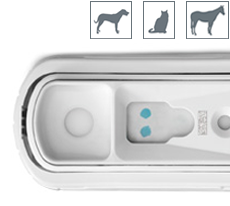SNAP Total T4 Test
Screen for hypo- and hyperthyroidism during patient visits
The new SNAP Total T4 Test provides convenient, clinically accurate results in-house in just 15 minutes for diagnosing and monitoring thyroid disease.
- The SNAP Total T4 Test results correlate extremely well with IDEXX Reference Laboratories methodology, eliminating confusion in result interpretation from one methodology to another.
- The test simplifies your work flow with one single dynamic range and one sample volume for canine, feline and equine patients.
- It’s fully quantitative, so you can monitor the course of thyroid disease, evaluate therapeutic responses and better assess disease progression during patient visits.
Benefits
SNAP Total T4 Test - Accurate Results in-house in 15 minutes
| In the morning, take out one SNAP Total T4 device and replace it when you use it.* | 0 minutes |
| Use plasma from the same sample you draw for chemistries | 2 minutes |
| Incubate sample and prepare your SNAP Total T4 Test | 6 minutes |
| Run the SNAP Total T4 Test (average run time). | 7 minutes |
| TOTAL TIME TO RUN SNAP Total T4 Test | 15 MINUTES |
*SNAP Total T4 devices require 15 minutes to warm up if not removed from the refrigerator in advance.
The SNAP Total T4 Test lets you:
- Screen, monitor and diagnose thyroid disease with one easy work flow and begin treatment or follow-up testing in the same visit.
- See immediate results. Diagnose, adjust therapy and dispense medication during the patient visit for improved real-time patient care and increased client compliance and satisfaction.
- Include a total T4 test as part of your routine wellness screen along with a CBC and chemistry profile.
- Perform reflex testing immediately: 66–75% of hypothyroid dogs have elevated cholesterol, and more than 90% of hyperthyroid cats show increases in ALT or ALKP.1
Accuracy
The new SNAP Total T4 Test is a clinically accurate in-house testing option
We’ve thoroughly evaluated, studied and refined the new SNAP® Total T4 Test, so you can depend on your results.
- To ensure optimal accuracy, reliability and ease of use, we invested more than five years in research and development.
- The test was evaluated by 22 North American veterinary practices.
- More than 1,300 patient samples have been tested on the SNAPshot Dx® Analyzer.
The reference intervals and interpretive information for the new SNAP Total T4 Test are directly aligned, and correlate extremely well, with the IDEXX Reference Laboratories Total T4 test. A collaborative approach in the research and development of the SNAP Total T4 Test has eliminated confusion in result interpretation from one methodology to the other.
Run the new SNAP Total T4 Test on the SNAPshot Dx Analyzer to get the benefit of proven ELISA technology.
- State-of-the-art digital imaging system and proprietary image analysis algorithms produce reliable, accurate test results in your clinic.
- Accurately quantifies total T4 in either serum or plasma samples from dogs, cats and horses.
- A reliable and convenient option for screening and monitoring patients with thyroid disease using your in-house laboratory.
How To / Resources
Step 1
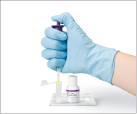 Following the on-screen instructions on the SNAPshot Dx Analyzer, dispense 65 µL of sample into a disposable tube. Make sure you use the purple pipette.
Following the on-screen instructions on the SNAPshot Dx Analyzer, dispense 65 µL of sample into a disposable tube. Make sure you use the purple pipette.
Step 2
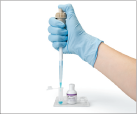 Dispense 300 µL of conjugate into the same sample tube used in step 1.
Dispense 300 µL of conjugate into the same sample tube used in step 1.
Step 3
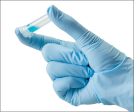 Gently invert the sample tube 4–5 times to mix.
Gently invert the sample tube 4–5 times to mix.
Step 4
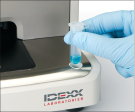 Incubate the sample tube for 5 minutes
Incubate the sample tube for 5 minutes
Step 5
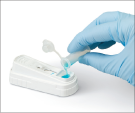 Pour entire contents of sample tube into the sample well of the SNAP* device.
Pour entire contents of sample tube into the sample well of the SNAP* device.
Step 6
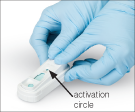 When color first appears in the activation circle, press the activator.
When color first appears in the activation circle, press the activator.
Step 7
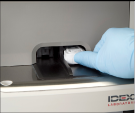 Immediately load the SNAP device into an available port on the analyzer.
Immediately load the SNAP device into an available port on the analyzer.
NOTE: So you’ll always be prepared, take a SNAP® Total T4 Test and conjugate out of the refrigerator in the morning to bring them to room temperature; replace the test as you use it.
View the package insert for detailed instructions.
Interpreting Results
Canine Reference Intervals
| U.S. Units (µg/dL) | SI Units (nmol/L) | ||
| <1.0 | Low | <13 | Low |
| 1.0–2.0 | Low Normal | <13–26 | Low Normal |
| 1.0–4.0 | Normal | 13–51 | Normal |
| >4.0 | High | >51 | High |
| 2.1–5.4 | Therapeutic | 27–69 | Therapeutic |
Equine Reference Intervals
| U.S. Units (µg/dL) | SI Units (nmol/L) | ||
| <1.0 | Low | <13 | Low |
| <1.0–3.8 | Normal | 13–49 | Low |
| >3.8 | High | >49 | High |
Note: 1 µg/dL is equal to 12.87 nmol/L.
Feline Reference Intervals
| U.S. Units (µg/dL) | SI Units (nmol/L) | ||
| <0.8 | Subnormal | <10 | Subnormal |
| 0.8-4.7 | Normal | 10-60 | Normal |
| 2.3-4.7 | Gray zone in old or symptomatic cats | 30-60 | Gray zone in old or symptomatic cats |
| >4.7 | Consistent with hyperthyroidism | >60 | Consistent with hyperthyroidism |
Questions & Answers
The SNAP T4/Total T4 Test measures total thyroxine, commonly referred to as “total T4” or “T4.”
Hyperthyroidism is a syndrome resulting from excessive production of thyroid hormones, resulting in an increased basal metabolism. Hyperthyroidism is the most common endocrinopathy in cats, but is very rare in dogs. Common clinical signs include weight loss, polyphagia, increased activity/restlessness/nervousness, hair loss/unkempt coat, polyuria/polydipsia, vomiting/diarrhea/bulky stools. Polycythemia, increased liver enzymes (ALT/ALKP) and hypokalemia are common laboratory findings.
Hyperthyroidism occurs in middle- to old-aged cats with a mean age of 11–13 years. It is rare in younger cats, but any cat over 4 years of age with compatible clinical signs should be screened. All cats over 7 years of age should be routinely screened for hyperthyroidism.
There are three primary treatment options available for hyperthyroid cats:
- Medical therapy
- Surgical removal of the thyroid gland (thyroidectomy: uncommon in North America)
- Radioactive iodine treatment
Yes, the SNAP T4/Total T4 Test is fully quantitative and enables you to monitor response to treatment. With the ability to monitor T4 levels in-house, you can make immediate adjustments to thyroid medication and discuss the course of illness and treatment while the client and patient are present.
The onset of clinical signs can occur at varying ages but generally appear during middle age (4–10 years). Some high-risk and large- or giant-breed dogs can develop signs at an earlier age (2–3 years). All dogs with compatible clinical signs should be screened for hypothyroidism.
The treatment of hypothyroidism involves thyroid supplement therapy. The goal is to treat the dog with the lowest possible dose that alleviates clinical signs and keeps the thyroid concentration in the upper end or slightly above the reference interval at peak levels (approximately 4–6 hours post-pill).
Yes, the SNAP T4/Total T4 Test is fully quantitative and enables you to monitor response to treatment. With the ability to monitor T4 levels in-house, you can make immediate adjustments to thyroid medication and discuss the course of illness and treatment while the client and patient are present.
The IDEXX Test Promise
If an IDEXX test does not perform as promised, simply call us and we will credit your IDEXX Points account with 100% of the test’s value in points.
If you have questions about the IDEXX Test Promise, please call us at 1300 44 33 99
Educational Partner
IDEXX is an Educational Partner of the American Association of Equine Practitioners

1. Feldman EC, Nelson RW. Canine and Feline Endocrinology and Reproduction. 3rd ed. Philadelphia, PA: WB Saunders; 2004.
